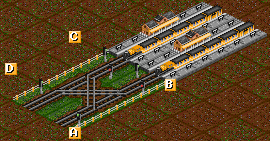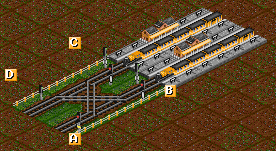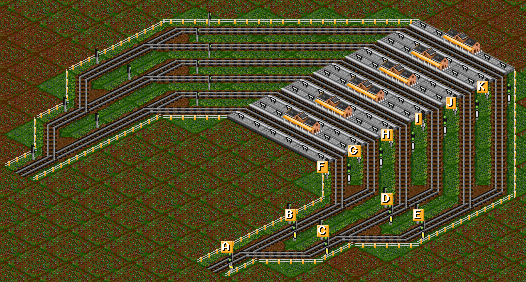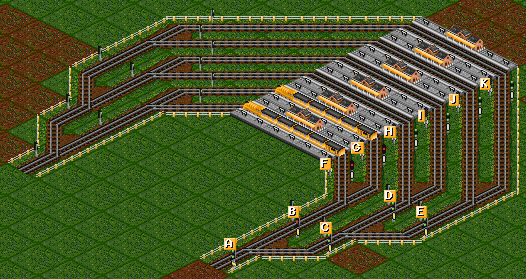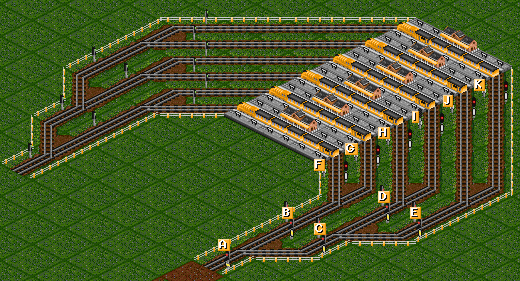Difference between revisions of "Presignal Basics"
From #openttdcoop wiki
Bodo Thiesen (Talk | contribs) m (fixed and/or improved inter guides linking) |
m (Added to basic networking category) |
||
| Line 36: | Line 36: | ||
[[Guides:Presignals|^^ Back to Presignals Guides Index]] | [[Oneway_or_Twoway_Presignals|Oneway or Twoway Presignals >>]] | [[Guides:Presignals|^^ Back to Presignals Guides Index]] | [[Oneway_or_Twoway_Presignals|Oneway or Twoway Presignals >>]] | ||
[[Category:Guides]] | [[Category:Guides]] | ||
| + | [[Category:Basic networking]] | ||
Revision as of 10:14, 4 December 2013
^^ Back to Presignals Guides Index | Oneway or Twoway Presignals >>
Contents
Presignal Basics
The Presignal Basics is explained here: how they work, how they behave, and how does work a terminal station, and whats the use of the combo presignal.
Part 1: Identify the signals
There are six types of signals in OTTD. If you click on a normal signal with CTRL is held, these signals will appear:
Normal Signal: It does not have any special alibity, it turns to red if the next signal block is blocked by any train.
Entry Presignal: It works like a normal signal, plus it turns to red if all exit presignals, or combo presignals are red after it.
Exit Presignal: It works same as normal signal, but it signs for the entry, or combo signals, if self is red.
Combo Presignal: It has both Entry and Exit presignal alibities: It turns to red if all Exit/Combo are red after it, and it signs for the Entry/Combo Presignals, if the self is red.
PBS Signal : Not a Presignal, it enables more trains in one signal block, since PBS means Path Based Signaling. This type of signal is not explained here.
One-Way PBS Signal : It works like a PBS Signal, however, it prohibits passing through from the back side. This type of signal is not explained here.
Part 2: The Station Problem
Stations without any presignals have a big problem: just have a look on the Image to the below. Signal A should be red... If you let one more train to enter into the station, it will block the exit, because A signal is green. This problem is solvable with presignals: Just turn A into Entry presignal, and turn B and C signals to exit signals. How does it work? If Exit Presignals B, C are both red, then Entry Presignal A is red too. Then a third train cannot pass trough Signal A.Part 3: An Effective RoRo station
Combo Presignals are mostly placed between Entry, and Exit presignals, because the Combo Presignals transmits the Exit presignal signs for the Entry Presignals. Combo presignals behave as an entry presignal and an exit presignal both. In the Image above, signal A is Entry Presignal, signals B, C, D, E are Combo ones, and F-K are Exit Presignals. If F and G Platforms are used, then Combo signal B uses its Entry Presignal alibity, and it will turn to red, because F, and G Exit Presignals are both red. But the Entry Presignal A is remains green. Exit presignals H-K are green, then Combo Presignals D, E is green, then Signal C is green too. With this Combo Presignal B is red and C is green, then the Entry Presignal A is remains green. The Entry Presignal A will be red only, if all Platforms are used, Exit Presignals F-K are red. If F-K are red, then all Combo Presignals B-E are red too, then the Entry A will be red.^^ Back to Presignals Guides Index | Oneway or Twoway Presignals >>
